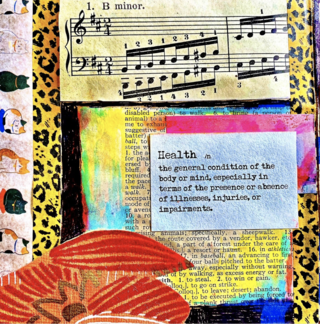
Imagination is a core component of expressive arts therapy, an integrative approach to treatment using movement, sound, image-making, enactment, play, and other forms of implicit communication (Malchiodi, 2020; 2022). Those of us who use these approaches recognize that processes that utilize the imagination are reparative when it comes to health and wellness. The benefits are not just relegated to a special group of individuals but are well-recognized as restorative practices possible for all.
Long ago, Winnicott (1971), noted that getting clients to learn to engage in imaginative play is a primary task of successful therapy. Many contemporary psychotherapists believe imagination sets the stage for engagement in treatment, positive shifts in thoughts and feelings, and, ultimately, the discovery of novel ways to overcome life’s challenges.
The Relationship Between Traumatic Stress and Imagination
People who experience long-lasting traumatic stress reactions may have challenges when it comes to imagination. In the earliest stages of psychotherapy, imagination may not be easy for those who have endured multiple traumatic events or have complex trauma. Imagination is dependent on a person’s ability to conceive of something beyond their established thoughts and dominant narratives. An individual with a history of trauma or early attachment disruptions may already have fixed physiological and emotional responses that interfere with the natural ability to imagine new possibilities.
A common experience among trauma survivors is the constant presence of fear. This can be a disruptive factor when it comes to accessing imagination. When I was a fine arts student, my instructors often brought up the concept of fear as a key deterrent to my artistic output. Challenging one’s fears is a common denominator taught in art school, where instructors propose that to do so separates artists who have the courage produce art and those who do not (Bayles & Orland, 2001). When extreme fear or terror are dominant trauma reactions, the ability to imagine may be unavailable, and repetitive traumatic narratives may be unyielding. Even playfulness can be frustrating for some individuals.
The restoration of an individual’s imaginative capacity may be one definition of healing when it comes to traumatic stress (Malchiodi, 2021). Bessel van der Kolk (2014) notes the role of imagination in the treatment of trauma:
Imagination is absolutely critical to the quality of our lives. Our imagination enables us to leave our routine, everyday existence by fantasizing about travel, food, sex, falling in love, or having the last word—all the things that make life interesting. Imagination gives us the opportunity to envision new possibilities—it is an essential launchpad for making our hopes come true. It fires our creativity, relieves our boredom, alleviates our pain, enhances our pleasure, and enriches our most intimate relationships.
Exposure Therapy Versus Imagination as Reparative Experiences
Research on brain imaging led by University of Colorado Boulder researchers (Reddan, Wagner, and Schiller, 2018) suggests that imagination can heal people with fears and anxieties, and those who struggle with trauma. Instead of providing typical exposure therapy, participants in the study were asked to simply imagine a threat for a few moments to help them cope with overwhelming bodily sensations associated with the threat. Participants were more able to adjust to a threat by visualizing it. If these results hold true in larger studies, it may mean that imagining a traumatic event can change the way our brain perceives (imagines) it. In other words, imagined and real exposure may not be so different, and imagination could work just as well.
There is anecdotal support for the importance of imagination in the restoration of health and well-being. Experiences utilizing the imagination seem to provide effective distractions from tenacious physiological reactions and recurrent thoughts related to traumatic events and stress. As more connections between imagination and trauma are realized, we will identify how to adapt psychotherapeutic strategies to assist those individuals who may not so easily engage in imagination and the creative process.
THE BASICS
But I Don’t Have Any Imagination!
This is a response I hear from many adults once they learn I will be introducing expressive and arts-based strategies to address traumatic stress reactions. To help these individuals, I more often use the term “expressive” than I do the more intimidating “imaginative” or even “creative.” We do all have various degrees and capacities when it comes to imagination, and developing these capacities is a process.
With individuals who wonder if they can be imaginative, I emphasize that we all can be expressive in one way or another, and there are many ways of being expressive that help us tap our imagination in safe and soothing ways. With survivors of complex trauma or those who have experienced multiple traumatic events, I add that, “we know that trauma can make for uncomfortable memories, feelings, and sensations that are pretty difficult to just erase. To help you use your imagination to support your own healing, let’s start with simple ways to regain your capacity for joy, curiosity, playfulness, confidence, and self-compassion.” Helping traumatized individuals discover just what forms of expression are self-regulating and restorative is where the development of reparative imagination begins. It is the starting place to replace distressful memories and body sensations with the imagination of new and hopefully, healing narratives.
Can Imagination Help Heal Trauma? - Psychology Today
Read More
Bagikan Berita Ini

















0 Response to "Can Imagination Help Heal Trauma? - Psychology Today"
Post a Comment